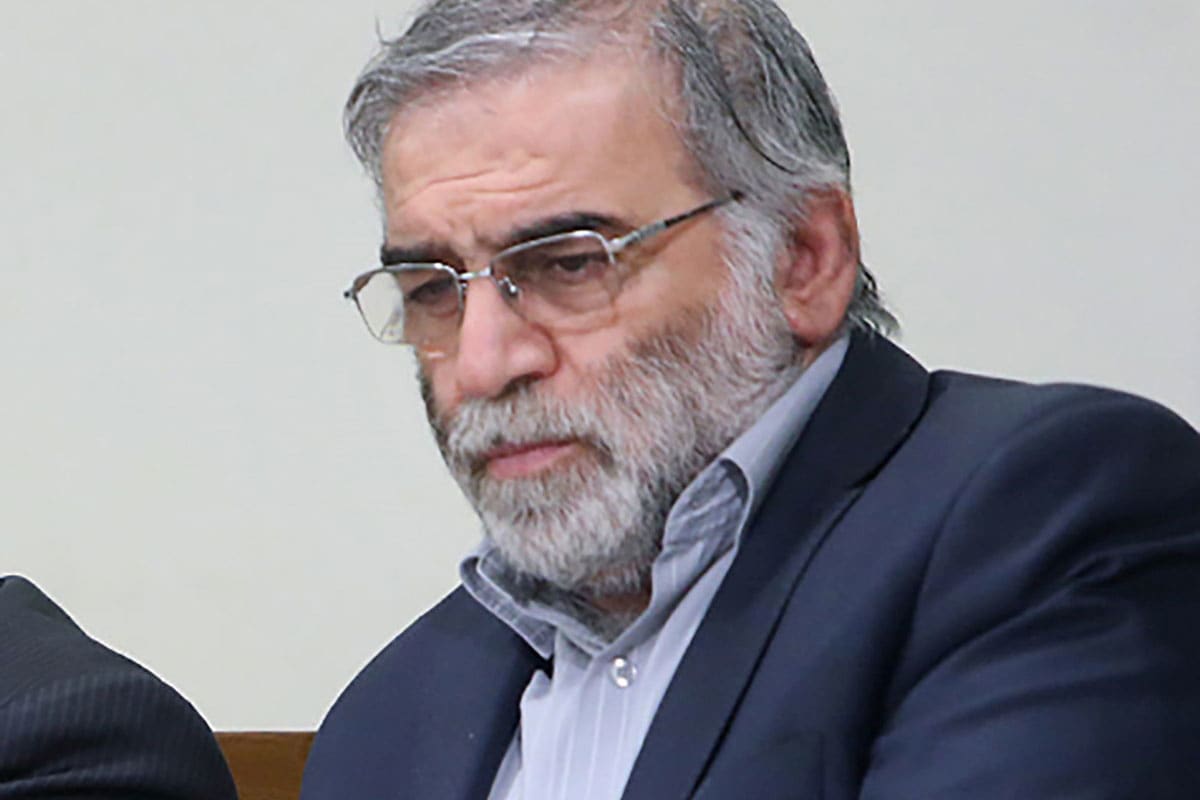Prominent Iranian scientist Mohsen Fakhrizadeh is seen in Iran, in this undated photo.
WANA | via Reuters
WASHINGTON — A top Iranian nuclear scientist has been assassinated near Tehran, Iran’s government confirmed Friday and alleged Israel was behind the killing without presenting evidence so far.
Mohsen Fakhrizadeh, dubbed the “father of the Iranian bomb,” died from his injuries after armed assassins fired upon his car, according to reports by Iranian media that have not been independently confirmed by NBC News.
State media shared photographs of a black Nissan sedan with multiple bullet holes through the windshield and bloodshed on the road next to the car door. No group has immediately claimed responsibility for Friday’s attack.
A view shows the scene of the attack that killed Prominent Iranian scientist Mohsen Fakhrizadeh, outside Tehran, Iran, November 27, 2020.
WANA via Reuters
Iranian Foreign Minister Javad Zarif condemned the killing on Twitter and alleged “serious indications” of Israeli involvement.
Fakhrizadeh’s death comes days before the 10-year anniversary of the killing of Iranian nuclear scientist Majid Shahriari, which Iran also blamed on Israel.
The Embassy of Israel in Washington, D.C., did not immediately respond to CNBC’s request for comment.
The Pentagon, Department of State and the National Security Council declined to comment. President Donald Trump did, however, retweet a news article and commentary about Fakhrizadeh’s death.
Little is known about Fakhrizadeh, a high-ranking Islamic Revolutionary Guard Corps officer, long viewed as Iran’s top nuclear scientist overseeing the regime’s secret weapons programs.
In 2018, Israeli Prime Minister Benjamin Netanyahu accused Iran of continuing to develop nuclear weapons and said Fakhrizadeh was working within Iran’s Defense Ministry on “special projects”.
“Remember that name, Fakhrizadeh,” Netanyahu said at the time.
Fakhrizadeh’s death is expected to escalate tensions between Iran and the United States, which have soared under the Trump administration following Washington’s exit from the landmark Iran nuclear agreement.
The standoff with Iran
Iranian President Hassan Rouhani makes a speech during a ceremony in Tehran, Iran on January 10, 2019.
Anadolu Agency | Anadolu Agency | Getty Images
The 2015 Joint Comprehensive Plan of Action, or JCPOA accord, brokered by the Obama administration, lifted sanctions on Iran that had crippled its economy and cut its oil exports roughly in half. In exchange for sanctions relief, Iran accepted limits on its nuclear program until the terms expire in 2025.
In 2018, the Trump administration withdrew the United States from the JCPOA. Trump called the JCPOA the “worst deal ever.”
Trump has previously said that he wants to reach a broader deal with Iran that puts stricter limits on its nuclear and ballistic missile work and suppresses the regime’s role in regional proxy wars. Tehran has refused to negotiate while U.S. sanctions remain in place.
Following Washington’s exit from the nuclear deal, other signatories of the pact — France, Germany, the U.K., Russia and China — tried to keep the agreement alive.
In October, the United States unilaterally reimposed U.N. sanctions on Tehran through a snapback process, which other U.N. Security Council members have previously said Washington does not have the authority to execute because it withdrew from the nuclear deal in 2018.
The relationship between the U.S. and Iran took another turn for the worse during the summer of 2019 following a string of attacks in the Persian Gulf.
In June, U.S. officials said an Iranian surface-to-air missile shot down an American military surveillance drone over the Strait of Hormuz. Iran said the aircraft was over its territory.
That strike came a week after the U.S. blamed Iran for attacks on two oil tankers in the Persian Gulf region and after four tankers were attacked in May.
The U.S. in June slapped new sanctions on Iranian military leaders blamed for shooting down the drone. The measures also aimed to block financial resources for Iran’s Supreme Leader Ayatollah Ali Khamenei.
Tensions soared again in September of last year when the U.S. blamed Iran for strikes in Saudi Arabia on the world’s largest crude-processing plant and oil field.
That attack forced the kingdom to cut its production operations in half and triggered the largest spike in crude prices in decades and renewed concerns of a new war in the Middle East. Iran maintains that it was not behind the attacks.
Earlier this year, the U.S. carried out an airstrike that killed Qasem Soleimani, Iran’s top military commander.
Iranian mourners gather during the final stage of funeral processions for slain top general Qasem Soleimani, in his hometown Kerman on January 7, 2020.
Atta Kenare | AFP | Getty Images

